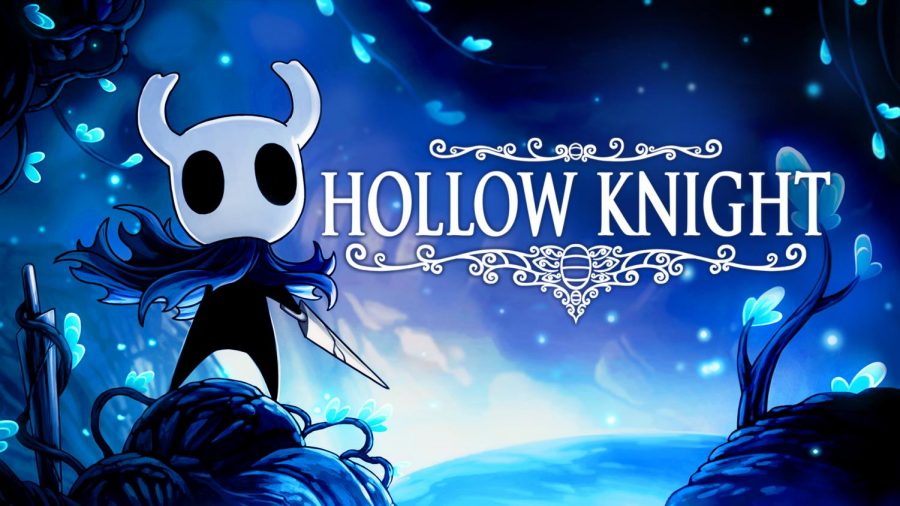The Hollow Knight Soundtrack
December 19, 2020
Hollow Knight: I could write about this one game forever and never be satisfied. Never have I played a game more beautiful, mysterious, or impressive than Hollow Knight. From the three-man developer team to the hand-drawn world of Hollownest, to the perfect score composed by Christopher Larkin to complement the game, Hollow Knight is nothing short of a masterpiece. And at a low price of $15 and a sequel in the works, there’s no better time to talk about the atmosphere that this game creates.
As this is a game soundtrack, each track is made to fit a certain area, event, or character in the world of Hollow Knight, and where most game soundtracks are used as simple generic background for gameplay, Christopher Larkin’s orchestral melodies take a front seat as one of the most important pieces of building the game’s world and atmosphere. “Dirtmouth,” for example, is the perfect track to fit the small bug village of the same name. The track is slow, somber, and evokes a sense of loss and hopelessness, which perfectly accents the dark, empty tones of color seen in the Dirtmouth, the Fading Town. Especially as Dirtmouth is the first location you will see when entering the game, it fantastically sets up the tone for the entire game: a lost, forgotten kingdom, filled with danger, and plagued by death.
Christopher Larkin composed the soundtrack with classic orchestral sounds above all else. Strings and winds take center stage, as heard in the fast, aggressive violin and cello tones that lead the melody in “Hornet”, or the bombastic, loud brass tones heard in “Dung Defender”. However, at times you may hear percussive or choral leads throughout the soundtrack, such as the beautiful vocal work of Amelia Jones as the soprano soloist in “City of Tears”, or the snare, bass, and other percussion highlighted in “Decisive Battle”. The Piano also has a heavy influence over some tracks, such as the previously mentioned “Dirtmouth.”
The musical styles expressed in this soundtrack vary greatly as well. Where “Dirtmouth” leaves you feeling hopeless and lost, “Mantis Lords” fills you with adrenaline, perfectly expressing the chaotic feeling of the battle it accompanies, where you are fighting three of the most trained fighters in the entire kingdom at the same time, walking a knife’s edge between hard-fought victory and swift death. The tone shifts again as you explore the Crystal Peak, the track of the same name creating a sense of mystery and curiosity, as you’re thrust into the darkness of the mines. Filled with machinery, wonder, and, as you venture further, beautiful glowing crystals, lighting your path through the industrial caverns. As you venture further, the track will build more and more, until a steady groove reigns over all else, with a powerful electric bassline motivating you to press on against all odds.
My favorite track off of the list, though every track is terrific in its way, has to be “Soul Sanctum.” Created to fit the area where the kingdoms brightest scholars performed horrifying experiments on themselves, it is one of the most thematic areas of Hollonest, and its music shares that with it. Starting with long organ tones that flow together to create a sense of sacrilege, it then shifts to a dark and intense percussive tone, where a choir comes in at the climax of the song to restate the melody laid by the organ. The song gets faster and faster, louder and louder and more intense, as the melody is passed among all the different voices and instruments, until it all slows down to a halt, leaving you alone again, having faced the horrors that lie in the tower.
Christopher Larkin had outdone himself in the creation of the beautiful soundtrack for Hollow Knight, but once the game had been released, he wasn’t done. The announcement of 4 expansion packs for Hollow Knight meant that he was back in action creating new music for these additions to the game. The full soundtrack for the 4 expansions was made into one, and “Hollow Knight: Gods and Nightmares” was born.
The first expansion, “Hidden Dreams,” added “White Defender,” a dream version of a boss already in the game. Christopher Larkin thought it fitting to take the original boss’s music (“Dung Defender”) and restyle it to better fit this new battle. It retains the heavy focus on brass and percussion, but adds a choral background and raises the stakes, adding new sections where the melody falls and rises quickly, as the fight is much more chaotic than the previous encounter. The addition of a very regal solo passed from wind player to wind player also adds characterization to the character you are fighting against, giving the player a peek at who he was before the fall of Hollownest, a knight of the highest order, driven by honor and a desire to defend his kingdom.
“The Grimm Troupe” expansion saw a strange and threatening new group of bugs arrive in Dirtmouth. Their leader, Grimm, wishes to fight the player to entertain the troupe. Christopher Larkin wrote two tracks for Grimm: “The Grimm Troupe” and “Nightmare King.” The former being a very fast and loud track, taking inspiration from carnival music and expressing emotions of carnal rage, making the player feel as if they are in far above their head. As the battle rages on, an onslaught of vocals joins the fray, as well as one of the most aggressive drumkit tracks I have ever heard. The latter is a second, more intense fight against Nightmare King Grimm, the true form of the troupe leader. This track starts with as much intensity as the climax of the last, and only raises the stakes from there, adding more rhythmic patterns to the mix, creating an atmosphere unrivaled in intensity by any other track on the list.
The penultimate expansion, “Lifeblood,” saw major improvements to the game as a whole, but added a new boss, the Hive Knight, and with it, a musical track to accompany the battle. “Hive Knight” is rhythm-oriented, with drums and keyboard percussion cutting through a crowd of heavy brass and fast, light woodwinds. The snare follows a very militaristic style of playing, fitting the theme of a soldier bee in a hive, followed by a brass section that emanates the honor and loyalty seen by a hive of bees, and the woodwinds’ light, quick movements up and down the musical scales expresses the speed and weightlessness of a bee.
The final, most showy expansion, “Godmaster,” sees the player travel to the ethereal plane of Godhome, where they must face an unforgiving gauntlet of their previously defeated foes notched up to 11, and even completely new versions of characters. Christopher Larkin echoed his work on “White Defender,” by adding on to existing tracks to complement some of the more important characters and battles in this expansion. This expansion is a desperate fight for your life from beginning to end, and fully completing all of Godhome’s trials is a task that requires mastery of all of Hollow Knight’s mechanics. The track “Hornet” has been changed significantly into “Daughter of Hollownest,” a track which now features an arrangement of choral voices singing the main theme, along with added winds and brass to raise the intensity.
Christopher Larkin created the perfect soundtrack for Hollow Knight, and no one could have done it better than him. His score tells the story of Hollownest and brings out the true colors of its inhabitants, as friendly or sinister as they may be. A sequel to Hollow Knight, known as Hollow Knight: Silksong, is currently being worked on by Team Cherry, and I was extremely happy to hear that Christopher Larkin has reprised his role and has already released some of the music that he’s composed for the game. There are many pieces of music that I did not highlight in this article, and I strongly urge you to listen to every track on Hollow Knight’s score.






















































































































































